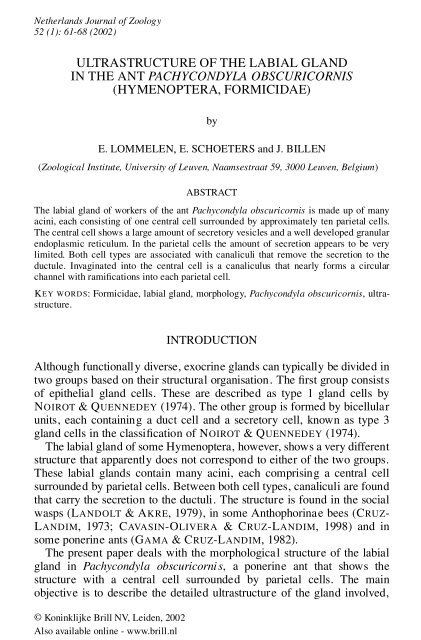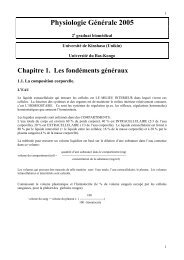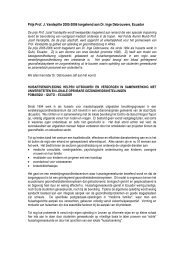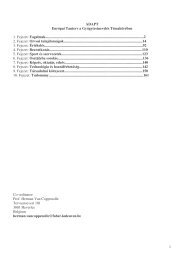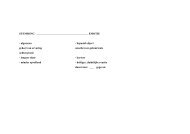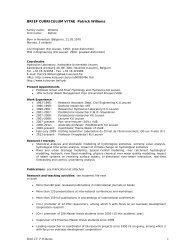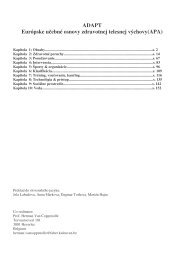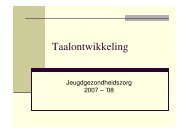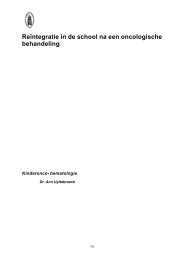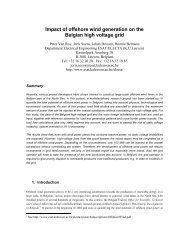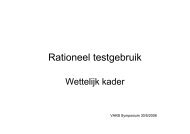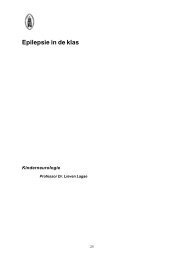www.kuleuven.ac.be
www.kuleuven.ac.be
www.kuleuven.ac.be
You also want an ePaper? Increase the reach of your titles
YUMPU automatically turns print PDFs into web optimized ePapers that Google loves.
Netherlands Journal of Zoology<br />
52 (1): 61-68 (2002)<br />
ULTRASTRUCTURE OF THE LABIAL GLAND<br />
IN THE ANT PACHYCONDYLA OBSCURICORNIS<br />
(HYMENOPTERA, FORMICIDAE)<br />
by<br />
E. LOMMELEN, E. SCHOETERS and J. BILLEN<br />
(Zoological Institute, University of Leuven, Naamsestraat 59, 3000 Leuven, Belgium)<br />
ABSTRACT<br />
The labial gland of workers of the ant P<strong>ac</strong>hycondyla obscuricornis is made up of many<br />
<strong>ac</strong>ini, e<strong>ac</strong>h consisting of one central cell surrounded by approximately ten parietal cells.<br />
The central cell shows a large amount of secretory vesicles and a well developed granular<br />
endoplasmic reticulum. In the parietal cells the amount of secretion appears to <strong>be</strong> very<br />
limited. Both cell types are associated with canaliculi that remove the secretion to the<br />
ductule. Invaginated into the central cell is a canaliculus that nearly forms a circular<br />
channel with rami cations into e<strong>ac</strong>h parietal cell.<br />
KEY WORDS: Formicidae, labial gland, morphology, P<strong>ac</strong>hycondyla obscuricornis, ultrastructure.<br />
INTRODUCTION<br />
Although functionally diverse, exocrine glands can typically <strong>be</strong> divided in<br />
two groups based on their structural organisation. The rst group consists<br />
of epithelial gland cells. These are descri<strong>be</strong>d as type 1 gland cells by<br />
NOIROT & QUENNEDEY (1974). The other group is formed by bicellular<br />
units, e<strong>ac</strong>h containing a duct cell and a secretory cell, known as type 3<br />
gland cells in the classi cation of NOIROT & QUENNEDEY (1974).<br />
The labial gland of some Hymenoptera, however, shows a very different<br />
structure that apparently does not correspond to either of the two groups.<br />
These labial glands contain many <strong>ac</strong>ini, e<strong>ac</strong>h comprising a central cell<br />
surrounded by parietal cells. Between both cell types, canaliculi are found<br />
that carry the secretion to the ductuli. The structure is found in the social<br />
wasps (LANDOLT & AKRE, 1979), in some Anthophorinae <strong>be</strong>es (CRUZ-<br />
LANDIM, 1973; CAVASIN-OLIVERA & CRUZ-LANDIM, 1998) and in<br />
some ponerine ants (GAMA & CRUZ-LANDIM, 1982).<br />
The present paper deals with the morphological structure of the labial<br />
gland in P<strong>ac</strong>hycondyla obscuricornis, a ponerine ant that shows the<br />
structure with a central cell surrounded by parietal cells. The main<br />
objective is to descri<strong>be</strong> the detailed ultrastructure of the gland involved,<br />
© Koninklijke Brill NV, Leiden, 2002<br />
Also available online - <strong>www</strong>.brill.nl
62 LOMMELEN, SCHOETERS & BILLEN<br />
this forming the rst ultrastructural study of the labial gland of this type<br />
in Formicidae. This appro<strong>ac</strong>h should allow us to get more insight into a<br />
functional-morphologica l context.<br />
MATERIALS AND METHODS<br />
Colonies of the ponerine ant P<strong>ac</strong>hycondyla obscuricornis Emery, 1890<br />
were collected at La Selva (Costa Rica) and kept in plaster nests. Labial<br />
glands of workers were dissected and xed in 2% glutaraldehyde, buffered<br />
in 0.05 M sodium c<strong>ac</strong>odylate with 0.15 M s<strong>ac</strong>charose. After post xation<br />
in 2% osmium tetroxide, tissues were dehydrated in a graded <strong>ac</strong>etone<br />
series and em<strong>be</strong>dded in araldite. Semithin sections (1 ¹m) were made<br />
with a Reichert OmU2 microtome, coloured with methylene blue-thionine<br />
and observed in a Zeiss Axioskop light microscope. Ultrathin sections of<br />
70 nm were made with a Reichert Ultr<strong>ac</strong>ut E microtome, double stained<br />
with lead citrate and uranyl <strong>ac</strong>etate and examined in a Zeiss EM900<br />
transmission electron microscope.<br />
Material for scanning microscopy was, after xation in glutaraldehyde,<br />
dehydrated in ethanol and critical point dried. Observation took pl<strong>ac</strong>e in a<br />
Philips XL 30 ESEM scanning microscope.<br />
RESULTS<br />
As in most insect species, P<strong>ac</strong>hycondyla obscuricornis workers have<br />
paired labial glands. The left and right ducts fuse in a common unpaired<br />
duct which in turn opens in the labium. In the thorax, the paired ducts are<br />
widened to form the reservoirs of the labial gland ( g. 1). Posteriorly to<br />
the reservoirs, the ducts ramify into many ductuli with an outer diameter<br />
Fig. 1. Top (left) and lateral view (right) of the anterior part of the thorax of P<strong>ac</strong>hycondyla<br />
obscuricornis showing the position of the labial gland (anterior side to the left).
LABIAL GLAND IN THE ANT PACHYCONDYLA OBSCURICORNIS 63<br />
of 5 ¹m and an inner diameter of 2 ¹m. They consist of a cuticular<br />
canal surrounded by epithelial cells, with a taenidial appearance of the<br />
cuticle. E<strong>ac</strong>h ductule ends in an <strong>ac</strong>inus ( gs 2, 3). The two groups of<br />
<strong>ac</strong>ini, forming the secretory part of the labial gland, are situated laterally<br />
of the gland reservoir ( g. 1).<br />
An <strong>ac</strong>inus has a diameter around 100 ¹m and consists of a large central<br />
cell surrounded by approximately ten parietal cells ( g. 4). The latter<br />
are partly invaginated into the central cell, which results in a globular<br />
appearance of the <strong>ac</strong>inus. The parietal cells in general do not touch e<strong>ac</strong>h<br />
other. The central cell and the parietal cells are associated with canaliculi,<br />
which remove the secretion from the cells to the ductulus.<br />
The central cell has a big central nucleus (50 ¹m diam.) with many<br />
nucleoli of variable size. The cytoplasm is for the greater part lled<br />
with secretory vesicles ( g. 5) with a substantial amount of granular<br />
endoplasmic reticulum <strong>be</strong>tween them. Peripherally some mitochondria<br />
are evident. The peripheral plasmalemma shows invaginations.<br />
The parietal cells are much smaller than the central cells and have a nucleus<br />
of approximately 10 ¹m diameter with many small nucleoli. With<br />
the aid of a light microscope, there is no secretion evident, but ultrastructurally<br />
small vesicles can <strong>be</strong> seen. They also have a less developed granular<br />
endoplasmic reticulum compared to the central cells. The canaliculi<br />
in the parietal cells are surrounded by numerous mitochondria. Near the<br />
basement membrane, the cell membrane shows invaginations with many<br />
mitochondria in <strong>be</strong>tween them. Apically, the cell membrane of the parietal<br />
cells is in cont<strong>ac</strong>t with the membrane of the central cell.<br />
The canaliculi show a rami ed system of small transportation canals<br />
that carry the secretory products towards the <strong>ac</strong>inar ductule. In contrast<br />
with the ductule, the canaliculi show no taenidia, and have a diameter of<br />
2 ¹m, which is the same as the inside of the ductule. The canaliculus<br />
forms nearly a circle around the central cell in order to re<strong>ac</strong>h all the<br />
parietal cells, as was con rmed by studying serial semithin sections<br />
and by dissecting canaliculi out of the <strong>ac</strong>inus. Every branch of the<br />
rami cations of the canaliculus ends in one parietal cell, as illustrated<br />
in gure 8. As the circular canaliculus has a diameter smaller than that of<br />
the central cell, it is inevitably invaginated into the latter. Histologically,<br />
the canaliculi consist of a lumen, surrounded by a perforated cuticle.<br />
Around this, the membranes of the central cell and the parietal cells show<br />
microvilli ( g. 5).<br />
In the central cell of some <strong>ac</strong>ini there is a large amount of secretion<br />
evident in <strong>be</strong>tween the microvilli and within the canaliculi. In gure 6, the<br />
emission of secretion from the central cell is shown very clearly. First the<br />
secretory vesicles fuse in the central cell. By exocytosis, the secretion will
64 LOMMELEN, SCHOETERS & BILLEN
LABIAL GLAND IN THE ANT PACHYCONDYLA OBSCURICORNIS 65<br />
<strong>be</strong> transported in <strong>be</strong>tween the microvilli and the cuticle. Then the secretion<br />
passes through the perforated cuticle that shows a granular appearance<br />
instead of different comp<strong>ac</strong>t layers like most cuticular structures. Finally<br />
the secretion will pass the canaliculi and will leave the <strong>ac</strong>inus via the<br />
ductulus.<br />
Where both central and parietal cells adhere, the structure of the membranes<br />
is complex. In the region near the canaliculi, the membranes of<br />
the central cell and the parietal cells are in close cont<strong>ac</strong>t with e<strong>ac</strong>h other<br />
through septate junctions ( g. 8). Because of the smaller diameter of the<br />
canaliculus compared to that of the central cell, the canaliculus is surrounded<br />
by an invagination of the cell membrane of the central cell ( g. 7).<br />
The membranes in this structure are tightened with septate junctions. The<br />
membrane of the parietal cell invaginates and as a consequence envelopes<br />
the blind ending part of the canaliculus in the parietal cell ( g. 8).<br />
DISCUSSION<br />
The structure of the labial gland with a central cell surrounded by<br />
parietal cells, as descri<strong>be</strong>d here for the ant P<strong>ac</strong>hycondyla obscuricornis,<br />
also occurs in a num<strong>be</strong>r of other ponerine ants such as P<strong>ac</strong>hycondyla<br />
striata, Neoponera villosa and Odontom<strong>ac</strong>hus chelifer (GAMA & CRUZ-<br />
LANDIM, 1982), as well as in social wasps (CRUZ-LANDIM & SAENZ,<br />
1972). In contrast with the organisation in these ants, the parietal cells<br />
in wasps occupy most of the <strong>ac</strong>inar surf<strong>ac</strong>e (LANDOLT & AKRE, 1979),<br />
while their canaliculi are usually situated in <strong>be</strong>tween the central cell and<br />
the parietal cells, and not invaginated into the central cell as descri<strong>be</strong>d<br />
here for P<strong>ac</strong>hycondyla obscuricornis. Also in wasps, e<strong>ac</strong>h parietal cell is<br />
Fig. 2. Scanning micrograph of some <strong>ac</strong>ini of the labial gland of P. obscuricornis. a =<br />
<strong>ac</strong>inus, d = ductulus. Scale bar: 50 ¹m.<br />
Fig. 3. Semithin section through a few <strong>ac</strong>ini. Scale bar: 50 ¹m.<br />
Fig. 4. Semithin section of an <strong>ac</strong>inus of P. obscuricornis. c = canaliculus, CC = central<br />
cell, CP = parietal cell, d = ductulus, s = secretion. Scale bar: 25 ¹m.<br />
Fig. 5. Ultrastructure of the canaliculus in the region <strong>be</strong>tween the central cell and a parietal<br />
cell. c = canaliculus, CC = central cell, CP = parietal cell, mv = microvilli. Scale bar:<br />
1 ¹m.<br />
Fig. 6. Ultrastructure of a canaliculus in the central cell which discharges secretion. c<br />
= canaliculus, rER = granular endoplasmic reticulum, mv = microvilli with secretion in<br />
<strong>be</strong>tween, s = secretion that is fused <strong>be</strong>fore emission, sv = secretory vesicle. Scale bar:<br />
5 ¹m.<br />
Fig. 7. Ultrastructure of a canaliculus which is invaginated into the central cell. c =<br />
canaliculus, CC = central cell, CP = parietal cell. Scale bar: 1 ¹m.
66 LOMMELEN, SCHOETERS & BILLEN<br />
Fig. 8. Schematic representation of an <strong>ac</strong>inus. c = canaliculus, CC = central cell, CP =<br />
parietal cell, d = ductulus, nc = nucleus of central cell, np = nucleus of parietal cell, r =<br />
rami cation of canaliculus, s = septate junctions.<br />
associated with one branch of the canaliculus. Furthermore the structural<br />
organisation of the cells is the same in wasps and in these ponerine ants.<br />
This structure may possibly represent a novel type of exocrine glands,<br />
<strong>be</strong>sides the epithelial glands and the secretory units descri<strong>be</strong>d by NOIROT<br />
& QUENNEDEY (1974). However, to clarify this further ontogenetic<br />
research of the gland is needed.<br />
The labial gland of some other insects also shows an <strong>ac</strong>inar structure,<br />
although this structure differs considerably with the presence of various<br />
types of epithelial cells surrounding a central lumen. Among these are zymogenic<br />
cells and peripheral cells, that are sometimes also called central<br />
resp. parietal cells. This structure is descri<strong>be</strong>d in the cockro<strong>ac</strong>hes Periplaneta<br />
americana (KESSEL & BEAMS, 1963) and Nauphoeta cinerea<br />
(BLAND & HOUSE, 1971), in the tettigoniid Homorochoryphus nitidulus<br />
(ANSTEE, 1975), and in the termites M<strong>ac</strong>rotermes <strong>be</strong>llicosus (BILLEN et<br />
al., 1989) and Serritermes serrifer (COSTA-LEONARDO, 1997).<br />
In P<strong>ac</strong>hycondyla obscuricornis, the central cell shows a lot of granular<br />
endoplasmic reticulum while the secretion has a granular appearance,<br />
which suggests the synthesis of a protein<strong>ac</strong>eous secretion. This is also<br />
the case in the zymogenic cells of the labial gland of Nauphoeta, where
LABIAL GLAND IN THE ANT PACHYCONDYLA OBSCURICORNIS 67<br />
these cells produce amylase and probably other enzymes, corresponding<br />
to their function in producing saliva (BLAND & HOUSE, 1971). DAY<br />
(1951) has found amylase and a mucoid substance in the zymogenic cells<br />
of the cockro<strong>ac</strong>h Periplaneta americana.<br />
There is hardly any production of protein<strong>ac</strong>eous secretion in the parietal<br />
cells, as shown by the scarce occurrence of secretory vesicles and<br />
granular endoplasmic reticulum. The numerous mitochondria that occur<br />
peripherally in the parietal cells most likely play a role in the <strong>ac</strong>tive transportation<br />
of nutrients through the cell membrane. In the heterometabolous<br />
species mentioned, the peripheral cells have a pyramidal shape. They have<br />
an intr<strong>ac</strong>ellular ductule lined by microvilli and their basal cell membrane<br />
is considerably infolded and <strong>ac</strong>companied by numerous mitochondria. In<br />
the cockro<strong>ac</strong>h Nauphoeta cinerea, these cells are probably responsible for<br />
the primary transport of water and ions into the gland (BLAND & HOUSE,<br />
1971).<br />
The secretion of the labial gland of P<strong>ac</strong>hycondyla obscuricornis is protein<strong>ac</strong>eous,<br />
but the precise composition of its secretion and the function<br />
are still unknown, and will require further research.<br />
ACKNOWLEDGEMENTS<br />
We are very grateful to K. Collart for making thin sections, to J. Cillis<br />
for scanning microscopy and B. Gobin for collecting colonies of P<strong>ac</strong>hycondyla<br />
obscuricornis. MINEAS gave permission to collect in Costa Rica<br />
(resolucion nr. 256-99-OFAU).<br />
REFERENCES<br />
ANSTEE, J.H., 1975. An electron microscopical study of the salivary glands of the<br />
tettigoniid, Homorochoryphus nitidulus. J. Insect Physiol. 21: 1073-1080.<br />
BILLEN, J., L. JOYE & R.H. LEUTHOLD, 1989. Fine structure of the labial gland in<br />
M<strong>ac</strong>rotermes <strong>be</strong>llicosus (Isoptera, Termitidae). Acta Zool. (Stockholm) 70: 37-45.<br />
BLAND, K.P. & C.R. HOUSE, 1971. Function of the salivary glands of the cockro<strong>ac</strong>h,<br />
Nauphoeta cinerea. J. Insect Physiol. 17: 2069-2084.<br />
CAVASIN-OLIVERA, G.M. & C. CRUZ-LANDIM, 1998. Ultrastructure of Apoidea<br />
(Hymenoptera, Anthophorinae) salivary glands. I. Alveolar glands. Revta Bras.<br />
Entomol. 42: 1-6.<br />
COSTA-LEONARDO, A.M., 1997. Secretion of salivary glands of the Brazilian termite<br />
Serritermes serrifer Hagen & Bates (Isoptera: Serritermitidae). Ann. Soc. Entomol.<br />
Fr. (N.S.) 33: 29-37.<br />
CRUZ-LANDIM, C., 1973. Tipos de glândulas salivares do torax presentes em a<strong>be</strong>lhas<br />
(Hymenoptera, Apoidea). Studia Ent. 16: 209-215.<br />
CRUZ-LANDIM, C. & M.H.P. SAENZ, 1972. Estudo comparativo de algumas glândulas<br />
dos Vespoidea (Hymenoptera). Papéis Avulsos Zool. 25: 251-263.
68 LOMMELEN, SCHOETERS & BILLEN<br />
DAY, M.F., 1951. The mechanism of secretion by the salivary gland of the cockro<strong>ac</strong>h<br />
Periplaneta americana (L.). Aust. J. Sci. Res. 4: 136-143.<br />
GAMA, V. & C. CRUZ-LANDIM, 1982. Estudo comparativo das glândulas do sistema<br />
salivar de formigas (Hymenoptera, Formicidae). Naturalia 7: 145-165.<br />
KESSEL, R.G. & H.W. BEAMS, 1963. Electron microscope observations on the salivary<br />
gland of the cockro<strong>ac</strong>h, Periplaneta americana. Z. Zellforsch. 59: 857-877.<br />
LANDOLT, P.J. & R.D. AKRE, 1979. Ultrastructure of the thorax gland of queens<br />
of the western yellowj<strong>ac</strong>ket Vespula pensylvanica (Hymenoptera: Vespidae). Ann.<br />
Entomol. Soc. Am. 72: 586-590.<br />
NOIROT, C. & A. QUENNEDEY, 1974. Fine structure of insect epidermal glands. Ann.<br />
Rev. Entomol. 19: 61-80.


